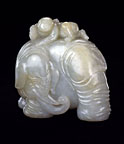Articles by Gary Gach
November 29, 2006 |
||||||||||
|
||||||||||
Scholar-curator Terese Tse Bartholomew’s work is known to many. In 1995, for example, she was instrumental in the Asian Art Museum of San Francisco organizing and presenting the the largest and most comprehensive collection of Mongolian art ever viewed in the United States, Mongolia: The Legacy of Chinggis Khan. Now she has generously endowed posterity, so to speak, as well as ourselves, with a landmark work in Chinese decorative art that's also splendid entry into many avenues for future research and sheer delight. Hidden Meanings is an exhibition which opened at the Asian Art Museum October 7, 2006 and runs through December 31, 2006, accompanied by an over-sized, indispensable book. First conceived with her thesis at UCLA, it's the fruit of nearly 40 years' labor, and the results are essential, exquisite, and utterly charming. The underlying theme is simple. When a Chinese person gives another Chinese person a gift, they might give and not say a thing. No need for words. The recipient will understand, because the gift is an auspicious symbol. To give a negative example, you wouldn’t want to buy someone a big old clock as a gift because “old clock” also means “to breathe one’s last.” A wristwatch will do. Or an elephant.
Cracking the code, as it were, often finds a four-character epigram hidden in the pictorial symbolism. “The fisherman receives the profit” (yuren deli), for instance, refers to an epigram from the Warring States dynasty. As the name of the dynasty reflects, people were often quarelling, and when two people give in to their anger, they don’t realize their fighting leaves the field open for a third person to come in and grab the spoils. The pictorial expression on display here is a small carving depicting a snipe with its beak caught in a clam, and a passing fisherman taking both of them away. One more example. “Leading one’s children to court,” wishes that a man’s sons follow in their father’s footsteps and become high officials. So a carving of a large fish together with a smaller fish in a tidal composition would suggest the phrase, because the Chinese words for fish and abundance sound alike (yu), reinforced by the fact that fish lay many eggs. So fish are associated with the wish for many children. And the words for tide and court (chao) are also cognates. To an outsider, a number of linguistic vectors intersect here, but to a Chinese person, it’s a natural part of their culture. After all, Chinese words are, at bottom, based on pictorial representation. And the Chinese language has more words than sounds, so one sound can mean several things. Who would have thought that cracks in a vase might be good? Yet crackles in glaze (sui) suggest suisui, year after year, and the vase itself (ping) is a visual pun on a word for peace (ping’an). It’s interesting to realize this tradition goes back 2,000 years. Yet scholars have remained aloof as to shedding any discernable useful light on this phenomenon. Decoding the spell (pardon the pun) for the rest of us, Mrs. Bartholomew has had to keep up with ever-changing trends. A jade carver, for instance, has shown her one of today’s latest gift choices: a carving incorporating white cabbage, since the words for white cabbage, fat choi, evoke wealth (think: gung hai fat choi, the Southern Chinese New Year's Greeting wishing that your wealth might increase over the coming year). In the West, we see a similar device at play in heraldry, known as canting. For example: the coat of arms of the Borough of Congleton, in Cheshire, contains a conger eel, a lion (leo) and a tun (another word for a barrel). The sequence spells “conger leo tun,” referring to the town’s name. In general, the Western rubric for this would be rebus, where an image is used to represent a sound (a pictogram for a phonogram). Setting aside sounds for a moment, considering just images, one begins to view the world as if it were a text. For instance, noodles are long, and thus evoke longevity; an excellent menu choice for your birthday.
And good things come in twos, as they say, especially in marriage, so the sight of fish swimming in pairs is a sign of a happy marriage. Mandarin ducks mate for life, and so they’re an ideal symbol of conjugal happiness. They might also be shown swimming alongside a lotus. Since a lotus comes to its seed-bearing stage early, this suggests the early arrival of children; plus, a word for lotus sounds like a word for harmony (he). Children can also be evoked by a melon or a gourd, which contain many seeds. Thus, under one emperor, pomegranates became a popular gift at the throne, as people wished him the blessing of quick sons, continually, and all succeeding in high office. The associations are, in and of themselves, enjoyable to contemplate, and the works of art on display are all superb and often sublime. Most of the 140 porcelains, jades, and textiles are culled from the museum’s famed Avery Brundage Collection and have never been seen before, such as a Qing dynasty vase with a 15th-century dragon design, but white-on-blue instead of blue-on-white. The book contains an additional 260 items, all divided into eight major categories, and is indexed in English, Pinyin, and by auspicious phrase. The Greek
root of the Western word symbolism means to bring together. We all owe
a great debt to Terese Tse Bartholomew for doing just that: bringing
it all together. |
||||||||||
| Gary
Gach is author of The Complete Idiot’s Guide to Understanding
Buddhism, and co-translator of Flowers of a Moment, Songs for
Tomorrow, and Ten Thousand Lives by Ko Un. Home page: http://word.to |
||||||||||
asianart.com | articles


